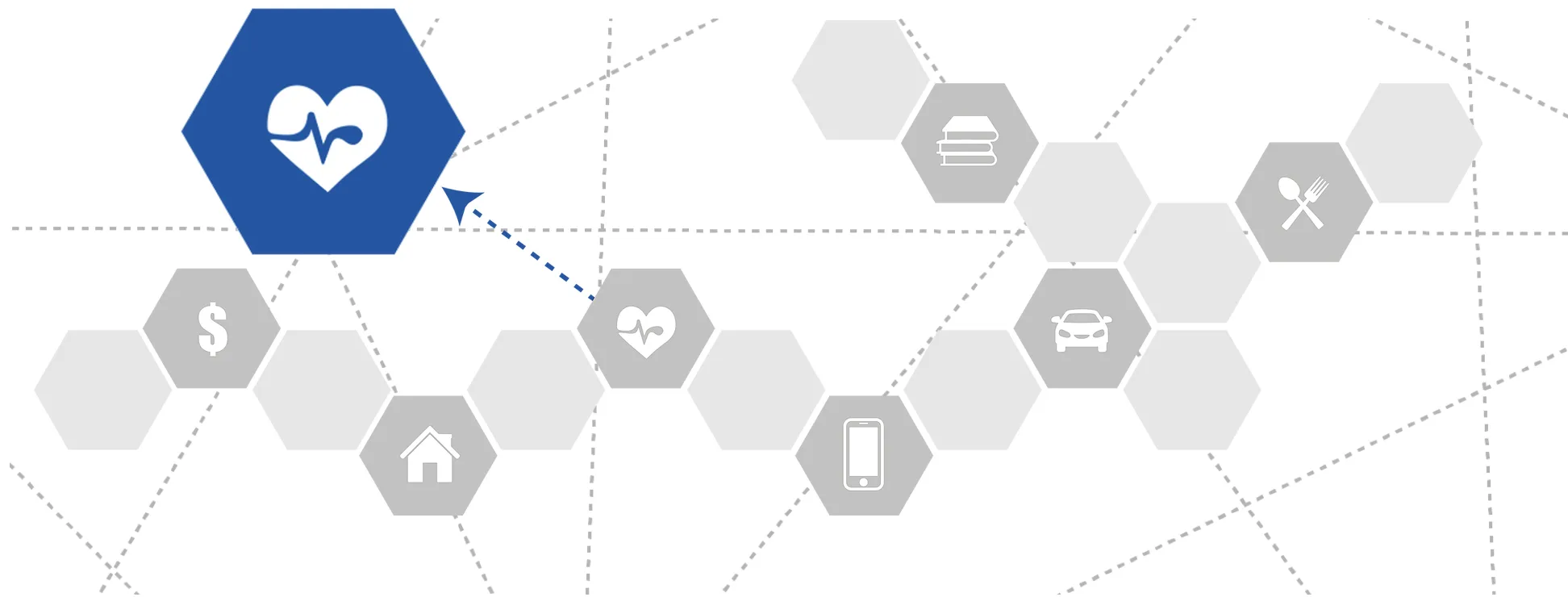
|
Housingclick to view |

|
Health Careclick to view |

|
Child Care and Educationclick to view |

|
Technologyclick to view |

|
Foodclick to view |

|
Taxesclick to view |

|
Transportationclick to view |
||
Broader Costs of Unaffordable Health Care
When ALICE households forgo or limit health care and insurance, or can’t afford to hire caregivers or live in healthier communities, their health and household finances suffer, but there are effects on the broader community as well:
- Lack of access to quality preventative care increases costs for all. When regular in-office care is hard to access, families often turn to the emergency room (ER), where the cost of treatment increases significantly for them or, if they cannot pay, for the state. The consequences of greater ER use for the wider community include longer wait times in ERs, as well as increases in health insurance premiums, the cost of charity care, and hospital community assistance.37
- Dental care moves to the ER. Dental care ER visits cost the U.S. health care system $1.6 billion in 2012, at an average cost of $749 per visit — and up to 79 percent of them could have been diverted to more cost-efficient community settings.38
- Untreated mental health and substance use issues shift problems to other areas. These issues increase ER and acute care costs, add to caseloads in the criminal justice system, and increase the costs of helping the homeless and the unemployed. Untreated or improperly treated mental illness also costs employees lost wages for absenteeism, and companies in decreased productivity. One study estimated that the annual cost to employers for mental-health absenteeism ranged from $10,000 for small organizations to over $3 million for large organizations.39
- Health problems increase work absences. Health issues in general also account for one-third of unscheduled absences from work, resulting in loss of wages for employees and costing employers over $225 billion annually.40
- The potential for Medicaid to improve community health is limited. Medicaid expansion makes a difference in health care access (e.g., increased insurance enrollment, affordability of care, and use of services), health care services (e.g., shorter hospital stays), and health outcomes (e.g., improved self-reported health and lower infant mortality).41 However, because Medicaid does not address the underlying social determinants of health (like housing, transportation, and social support), its ability to significantly improve community health is limited.42
- Family caregiving exacts a toll on the broader economy. Family caregiving for seniors costs employers approximately $13.4 billion in excess health care spending each year on employees who are caregivers, due to the toll that caregiving takes on the caregiver’s own health. In addition, the lost productivity due to absenteeism among full- and part-time caregivers costs the U.S. economy more than $20 billion per year.43
- Having a significant portion of a population vulnerable to poor health perpetuates the most fundamental forms of inequality. While life expectancy has increased for Black and low-income people, rates are still below those for wealthy White people, and stark disparities remain. The gap in life expectancy is as much as 30 years between the richest and poorest U.S. counties.44
Sources
37
Centers for Disease Control and Prevention (CDC). (2011, January 14). Health disparities and inequalities report, United States, 2011. Morbidity and Mortality Weekly Report (MMWR), 60(Supplement), 1–114. Retrieved from http://www.cdc.gov/mmwr/pdf/other/su6001.pdf
DeLia, D., & Lloyd, K. (2014, July). Sources of variation in avoidable hospital use and cost across low-income communities in New Jersey. Rutgers Center for State Health Policy. Retrieved from http://www.cshp.rutgers.edu/downloads/10470.pdf
Centers for Disease Control and Prevention (CDC). (2016). Emergency department visits. Retrieved from https://www.cdc.gov/nchs/fastats/emergency-department.htm
38
Wall, T., & Vujicic, M. (2015, April). Emergency department use for dental conditions continues to increase. American Dental Association. Retrieved from http://mediad.publicbroadcasting.net/p/wusf/files/201802/ADA.pdf
39
Harvard Medical School. (2010, February). Mental health problems in the workplace. Harvard Mental Health Letter. Retrieved from https://www.health.harvard.edu/newsletter_article/mental-health-problems-in-the-workplace
Parity Project, NAMi–-New York City Metro. (2003). Untreated and under-treated mental health problems — how are they hurting your business? Retrieved from http://www.mentalhealthpromotion.net/resources/untreated-and-undertreated-mental-health-problems-how-are-they-hurting-your-business.pdf
40
CDC Foundation. (2015, January 28). Worker illness and injury costs U.S. employers $225.8 billon annually. Retrieved from https://www.cdcfoundation.org/pr/2015/worker-illness-and-injury-costs-us-employers-225-billion-annually
41
Antonisse, L., Garfield, R., Rudowitz, R., & Artiga, S. (2018, March 28). The effects of Medicaid expansion under the ACA: Updated findings from a literature review. Kaiser Family Foundation. Retrieved from https://www.kff.org/medicaid/issue-brief/the-effects-of-medicaid-expansion-under-the-aca-updated-findings-from-a-literature-review-march-2018/
42
Sommers, B., Blendon, R., & Orav, E. (2016, October). Changes in utilization and health among low-income adults after Medicaid expansion or expanded private insurance. JAMA Internal Medicine, 176(10), 1501–1509. Retrieved from http://jamanetwork.com/journals/jamainternalmedicine/article-abstract/2542420
43
Witters, D. (2018). Uninsured rate rises in 17 states in 2017. Gallup. Retrieved from https://news.gallup.com/poll/233597/uninsured-rate-rises-states-2017.aspx?g_source=link_NEWSV9&g_medium=TOPIC&g_campaign=item_&g_content=Uninsured%2520Rate%2520Rises%2520in%252017%2520States%2520in%25202017
MetLife Mature Market Institute. (2010, February). The MetLife study of working caregivers and employer health care costs. Retrieved from https://nrrs.ne.gov/respite/employers/docs/metlife_working-caregivers-employers-health-care-costs.pdf
44
Powell, A. (2016, February 22). The costs of inequality: Money = quality healthcare = longer life. Harvard Gazette. Retrieved from https://news.harvard.edu/gazette/story/2016/02/money-quality-health-care-longer-life/

